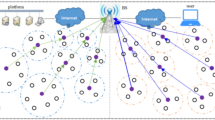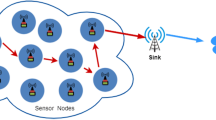Abstract
Usually, Wireless Sensor Network operates in a wide range of untrustworthy environments that are deployed in an ad-hoc approach. Although different cluster-based schemes have been proposed for improving network lifetime, however, most of the existing solutions incur probabilistic methods, which result in non-uniform energy consumption and imbalanced load distribution. In addition, end-to-end route discovery is non-optimized in terms of the limited resources of sensor nodes, which leads to frequent route discoveries and network overheads. In this research paper, we present Weighted Energy-Efficient Clustering with Robust Routing (WECRR) protocol that maintains balanced energy consumption and improves network-wide data delivery performance. The contributions of our proposed WECRR protocol are: Firstly, WECRR initiates a deterministic approach to avoid the uncertainties in Cluster Heads election mechanism and performs bounded clustering mechanism. Secondly, it provides multi-level optimized routing decision by making use of multi-facet attributes. At the end, it provides a route maintenance strategy, upon encounters any faulty or exhausted nodes on primary route, which results in reducing re-transmissions and route breakages. Simulation results reveal improved performance of WECRR protocol than compared to existing work.


















Similar content being viewed by others
References
Abbasi, A. Z., Islam, N., & Shaikh, Z. A. (2014). A review of wireless sensors and networks’ applications in agriculture. Computer Standards & Interfaces, 36(2), 263–270.
Alamri, A., et al. (2013). A survey on sensor-cloud: Architecture, applications, and approaches. International Journal of Distributed Sensor Networks, 2013, 1–19.
Lee, S. H., et al. (2009).Wireless sensor network design for tactical military applications: remote large-scale environments. In Military communications conference, 2009. MILCOM 2009, IEEE. Boston, MA: IEEE.
Ahmed, A., et al. (2015). A survey on trust based detection and isolation of malicious nodes in ad-hoc and sensor networks. Frontiers of Computer Science, 9(2), 280–296.
Sha, K., Gehlot, J., & Greve, R. (2013). Multipath routing techniques in wireless sensor networks: A survey. Wireless Personal Communications, 70(2), 807–829.
Lazarescu, M. T. (2013). Design of a WSN platform for long-term environmental monitoring for IoT applications. IEEE Journal on Emerging and Selected Topics in Circuits and Systems, 3(1), 45–54.
Lou, C., & Zhuang, W. (2016). Energy-efficient routing over coordinated sleep scheduling in wireless ad hoc networks. Peer-to-Peer Networking and Applications, 9(2), 384–396.
Vasilakos, A. V., et al. (2015). Information centric network: Research challenges and opportunities. Journal of Network and Computer Applications, 52, 1–10.
Liu, Z., et al. (2010). An effective scheduling scheme for multi-hop multicast in wireless mesh networks. Frontiers of Computer Science in China, 4(1), 135–142.
Batra, P. K., & Kant, K. (2016). LEACH-MAC: A new cluster head selection algorithm for wireless sensor networks. Wireless Networks, 22(1), 49–60.
Lee, I., Shaw, W., & Park, J. H. (2010). On prolonging the lifetime for wireless video sensor networks. Mobile Networks and Applications, 15(4), 575–588.
Liu, L., Hu, B., & Li, L. (2010). Algorithms for energy efficient mobile object tracking in wireless sensor networks. Cluster Computing, 13(2), 181–197.
Manap, Z., et al. (2013). A review on hierarchical routing protocols for wireless sensor networks. Wireless Personal Communications, 72(2), 1077–1104.
Nam, C.-S., Jeong, H.-J., & Shin, D.-R. (2008). The adaptive cluster head selection in wireless sensor networks. In Semantic computing and applications, 2008. IWSCA’08. IEEE international workshop. Incheon: IEEE.
Heinzelman, W. R., Chandrakasan, A., & Balakrishnan, H. (2000). Energy-efficient communication protocol for wireless microsensor networks. In Proceedings of the 33rd annual Hawaii international conference on system sciences. Maui: IEEE.
Younis, O., & Fahmy, S. (2004). HEED: A hybrid, energy-efficient, distributed clustering approach for ad hoc sensor networks. IEEE Transactions on Mobile Computing, 3(4), 366–379.
Lindsey, S., & Raghavendra, C. S. (2002). PEGASIS: Power-efficient gathering in sensor information systems. In Aerospace conference proceedings, IEEE. IEEE.
Park, G. Y., et al. (2013). A novel cluster head selection method based on k-means algorithm for energy efficient wireless sensor network. In 2013 27th international conference on advanced information networking and applications workshops (WAINA). Barcelona: IEEE.
Mahajan, S., Malhotra, J., & Sharma, S. (2014). An energy balanced QoS based cluster head selection strategy for WSN. Egyptian Informatics Journal, 15(3), 189–199.
Arumugam, G. S., & Ponnuchamy, T. (2015). EE-LEACH: Development of energy-efficient LEACH Protocol for data gathering in WSN. EURASIP Journal on Wireless Communications and Networking, 2015(1), 1–9.
Jiang, D., Xu, Z., & Lv, Z. (2016). A multicast delivery approach with minimum energy consumption for wireless multi-hop networks. Telecommunication Systems, 62(4), 771–782.
Mamalis, B., et al. (2009) Clustering in wireless sensor networks. In Zhang/RFID and sensor networks (pp. 324–350).
Dahnil, D. P., Singh, Y. P., & Ho, C. K. (2012). Topology-controlled adaptive clustering for uniformity and increased lifetime in wireless sensor networks. IET Wireless Sensor Systems, 2(4), 318–327.
Ruan, F., et al. (2013). A distance clustering routing algorithm considering energy for wireless sensor networks. International Journal of Future Generation Communication and Networking, 6(5), 73–80.
Kang, S. H., & Nguyen, T. (2012). Distance based thresholds for cluster head selection in wireless sensor networks. IEEE Communications Letters, 16(9), 1396–1399.
Venkanna, U., & Velusamy, R. L. (2016). TEA-CBRP: Distributed cluster head election in MANET by using AHP. Peer-to-Peer Networking and Applications, 9(1), 159–170.
Nayak, P., & Devulapalli, A. (2016). A fuzzy logic-based clustering algorithm for WSN to extend the network lifetime. IEEE Sensors Journal, 16(1), 137–144.
Weng, C.-E., & Lai, T.-W. (2013). An energy-efficient routing algorithm based on relative identification and direction for wireless sensor networks. Wireless Personal Communications, 69(1), 1–16.
Zhao, L., Chen, Z., & Sun, G. (2014). Dynamic cluster-based routing for wireless sensor networks. Journal of Networks, 9(11), 2951–2956.
Ortiz, A. M., et al. (2013). Fuzzy-logic based routing for dense wireless sensor networks. Telecommunication Systems, 52(4), 2687–2697.
Jiang, H., Sun, Y., Sun, R., & Xu, H. (2013). Fuzzy-logic-based energy optimized routing for wireless sensor networks. International Journal of Distributed Sensor Networks, 2013, 216561.
Fersi, G., Louati, W., & Jemaa, M. B. (2013). Distributed Hash table-based routing and data management in wireless sensor networks: A survey. Wireless Networks, 19(2), 219–236.
Damdinsuren, C., et al. (2013). Lifetime extension based on residual energy for receiver-driven multi-hop wireless network. Cluster Computing, 16(3), 469–480.
Naeimi, S., et al. (2012). A survey on the taxonomy of cluster-based routing protocols for homogeneous wireless sensor networks. Sensors, 12(6), 7350–7409.
Venkateswarlu Kumaramangalam, M., Adiyapatham, K., & Kandasamy, C. (2014). Zone-based routing protocol for wireless sensor networks. International Scholarly Research Notices, 2014, 1–9.
Amgoth, T., & Jana, P. K. (2015). Energy-aware routing algorithm for wireless sensor networks. Computers & Electrical Engineering, 41, 357–367.
Kuila, P., & Jana, P. K. (2014). Approximation schemes for load balanced clustering in wireless sensor networks. The Journal of Supercomputing, 68(1), 87–105.
Das, S. K., Tripathi, S., & Burnwal, A. (2015). Intelligent energy competency multipath routing in wanet. In Information systems design and intelligent applications (pp. 535–543). Springer.
Wu, D., et al. (2014). Joint multi-radio multi-channel assignment, scheduling, and routing in wireless mesh networks. Wireless Networks, 20(1), 11–24.
Thakkar, A., & Kotecha, K. (2014). Cluster head election for energy and delay constraint applications of wireless sensor network. IEEE Sensors Journal, 14(8), 2658–2664.
Zhang, D.-G., et al. (2015). A novel multicast routing method with minimum transmission for WSN of cloud computing service. Soft Computing, 19(7), 1817–1827.
Jin, R.-C., et al. (2013). Passive cluster-based multipath routing protocol for wireless sensor networks. Wireless Networks, 19(8), 1851–1866.
Tsai, C.-H., & Tseng, Y.-C. (2012). A path-connected-cluster wireless sensor network and its formation, addressing, and routing protocols. IEEE Sensors Journal, 12(6), 2135–2144.
Cota-Ruiz, J., et al. (2016). A recursive shortest path routing algorithm with application for wireless sensor network localization. IEEE Sensors Journal, 16(11), 4631–4637.
Lin, K., et al. (2012). Energy efficiency routing with node compromised resistance in wireless sensor networks. Mobile Networks and Applications, 17(1), 75–89.
Bajaber, F., & Awan, I. (2009). Base-station controlled dynamic clustering protocol. In Proceedings of international conference on advanced information networking and applications. Bradford, UK.
Jannatul Ferdous, M., Ferdous, J., & Dey T. (2009). Central base-station controlled density aware clustering protocol for wireless sensor networks In 12th international conference on computers and information technology, 2009. ICCIT’09. Dhaka: IEEE.
Xinhua, W., & Sheng, W. (2010). Performance comparison of LEACH and LEACH-C protocols by NS2. In 2010 ninth international symposium on distributed computing and applications to business engineering and science (DCABES). Hong Kong: IEEE.
Zhao, F., Xu, Y., & Li, R. (2012). Improved LEACH routing communication protocol for a wireless sensor network. International Journal of Distributed Sensor Networks, 2012(2012), 1–5.
Sasikumar, P., & Khara, S. (2012). K-means clustering in wireless sensor networks. In 2012 fourth international conference on computational intelligence and communication networks (CICN). IEEE.
Peng, W., & Edwards, D. J. (2010). K-means like minimum mean distance algorithm for wireless sensor networks. In 2010 2nd international conference on computer engineering and technology (ICCET). IEEE.
Yu, J., et al. (2012). A cluster-based routing protocol for wireless sensor networks with nonuniform node distribution. AEU-International Journal of Electronics and Communications, 66(1), 54–61.
Ever, E., et al. (2012). UHEED-an unequal clustering algorithm for wireless sensor networks (pp. 1–9). Rome.
Xuhui, C., Zhiming, Y., & Huiyan, C. (2009). Unequal clustering mechanism of leach protocol for wireless sensor networks. In Computer science and information engineering, 2009 WRI world congress. Los Angeles, CA: IEEE.
Chen, G., et al. (2009). An unequal cluster-based routing protocol in wireless sensor networks. Wireless Networks, 15(2), 193–207.
Mao, S., et al. (2013). An improved fuzzy unequal clustering algorithm for wireless sensor network. Mobile Networks and Applications, 18(2), 206–214.
Nguyen, T. T., Shieh, C. S., Horng, M. F., Ngo, T.-G., & Dao, T.-K. (2015). Unequal clustering formation based on bat algorithm for wireless sensor networks. Knowledge and Systems Engineering. doi:10.1007/978-3-319-11680-8_53.
Gong, B., & Jiang, T. (2011). A tree-based routing protocol in wireless sensor networks. In 2011 International conference on electrical and control engineering (ICECE). IEEE.
Zhou, Z., et al. (2014). EGF-tree: An energy-efficient index tree for facilitating multi-region query aggregation in the internet of things. Personal and Ubiquitous Computing, 18(4), 951–966.
Azharuddin, M., Kuila, P., & Jana, P. K. (2015). Energy efficient fault tolerant clustering and routing algorithms for wireless sensor networks. Computers & Electrical Engineering, 41, 177–190.
Samanta, M., & Banerjee, I. (2014). Optimal load distribution of cluster head in fault-tolerant wireless sensor network. In 2014 IEEE students’ conference electrical, electronics and computer science (SCEECS). Bhopal: IEEE.
Author information
Authors and Affiliations
Corresponding author
Rights and permissions
About this article
Cite this article
Haseeb, K., Bakar, K.A., Ahmed, A. et al. WECRR: Weighted Energy-Efficient Clustering with Robust Routing for Wireless Sensor Networks. Wireless Pers Commun 97, 695–721 (2017). https://doi.org/10.1007/s11277-017-4532-5
Published:
Issue Date:
DOI: https://doi.org/10.1007/s11277-017-4532-5




